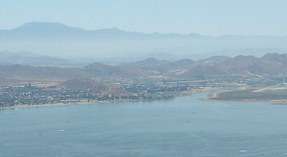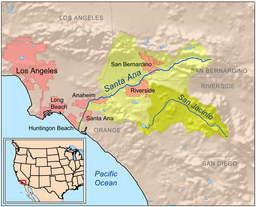San Jacinto River (California)
| San Jacinto River | |
| River | |
 The mouth of the San Jacinto on Lake Elsinore, viewed from California State Route 74 (the Ortega Highway) on the southwest side of the lake | |
| Country | United States |
|---|---|
| State | California |
| Region | Riverside County |
| Part of | Santa Ana River basin |
| Tributaries | |
| - left | South Fork San Jacinto River |
| - right | North Fork San Jacinto River |
| Cities | Hemet, San Jacinto, Perris, Lake Elsinore |
| Source | San Jacinto Mountains |
| - location | San Bernardino National Forest, Riverside County |
| - elevation | 2,100 ft (640 m) |
| - coordinates | 33°43′52″N 116°48′36″W / 33.73111°N 116.81000°W [1] |
| Mouth | Lake Elsinore |
| - location | Lake Elsinore, at the mouth of Railroad Canyon, northwest of the Sedco Hills and west of the Tuscany Hills of the Temescal Mountains., Riverside County |
| - elevation | 1,243 ft (379 m) |
| - coordinates | 33°38′45.06″N 117°18′53.42″W / 33.6458500°N 117.3148389°WCoordinates: 33°38′45.06″N 117°18′53.42″W / 33.6458500°N 117.3148389°W |
| Length | 42 mi (68 km), Northwest then southwest |
| Basin | 780 sq mi (2,020 km2) [2] |
| Discharge | |
| - average | 16.4 cu ft/s (0 m3/s) [3] |
| - max | 16,000 cu ft/s (453 m3/s) |
| - min | 0 cu ft/s (0 m3/s) |
 Map of the Santa Ana River watershed with the San Jacinto subbasin highlighted in darker green. | |
The San Jacinto River is a 42-mile-long (68 km)[4] river in Riverside County, California. The river's headwaters are in San Bernardino National Forest, but the lower portion of the 765-square-mile (1,980 km2) watershed is urban and agricultural land. As an endorheic watershed that is contiguous with other Great Basin watersheds, the western side of the San Jacinto Basin is a portion of the Great Basin Divide.
Course
The river is formed at the west base of the San Jacinto Mountains by the confluence of its North and South forks. The South Fork flows from near Santa Rosa Summit, through Pine Meadow and Garner Valley to Lake Hemet, which holds 14,000 acre feet (17,000,000 m3) of water. Hemet Dam was built in 1895 to supply water to the city of Hemet. Downstream of the dam, the South Fork joins the North Fork east of the town of Valle Vista near Highway 74, and the main stem of the San Jacinto River continues northwest until it discharges into Mystic Lake, a couple of miles east of Lake Perris. Overflow from the river then flows southwest, passing under Ramona Expressway and Interstate 215, and through Railroad Canyon to Railroad Canyon Reservoir, also called Canyon Lake, which has a capacity of 11,900 acre feet (14,700,000 m3). Downstream of Railroad Canyon Dam, the river continues flowing roughly west southwest through the canyon through the Temescal Mountains for about 3 miles (4.8 km) until it drains into Lake Elsinore. The lake has very little outflow, but in years of heavy rainfall it has overflowed into Temescal Creek, a tributary of the Santa Ana River, that flows northwest to that river in Corona, California.
List of tributaries of the San Jacinto River
- Cottonwood Canyon Creek[5] in Railroad Canyon
- Canyon Lake in Railroad Canyon
- Perris Valley Channel[8]
- Bautista Creek[9]
- Indian Creek[10]
- North Fork San Jacinto River[11]
- South Fork San Jacinto River[16]
References
- ↑ "San Jacinto River". Geographic Names Information System. United States Geological Survey. 1981-01-19. Retrieved 2010-11-22.
- ↑ "San Jacinto River Watershed: Geographic Setting". Lake Elsinore and Canyon Lake Task Force. Santa Ana Watershed Project Authority. Retrieved 2010-11-22.
- ↑ "USGS Gage #11070500 on the San Jacinto River near Elsinore, CA" (PDF). National Water Information System. U.S. Geological Survey. 1916–2009. Retrieved 2010-11-22.
- ↑ U.S. Geological Survey. National Hydrography Dataset high-resolution flowline data. The National Map, accessed March 16, 2011
- ↑ U.S. Geological Survey Geographic Names Information System: Cottonwood Canyon
- ↑ USGS Mouth: 33°40′42″N 117°14′07″W / 33.67833°N 117.23528°W
- ↑ City of Menifee General Plan Draft EIR, City of Menifee, The Planning Center, DC&E, September 2013, Page 5.9-1 Environmental Setting; Local Surface Waters and Drainage; Salt Creek
- ↑ U.S. Geological Survey Geographic Names Information System: Perris Valley Storm Drain
- ↑ U.S. Geological Survey Geographic Names Information System: Bautista Creek
- ↑ U.S. Geological Survey Geographic Names Information System: Indian Creek
- ↑ U.S. Geological Survey Geographic Names Information System: North Fork San Jacinto River
- ↑ U.S. Geological Survey Geographic Names Information System: Logan Creek
- ↑ U.S. Geological Survey Geographic Names Information System: Stone Creek
- ↑ U.S. Geological Survey Geographic Names Information System: Black Mountain Creek
- ↑ U.S. Geological Survey Geographic Names Information System: Fuller Mill Creek
- ↑ U.S. Geological Survey Geographic Names Information System: South Fork San Jacinto River
- ↑ U.S. Geological Survey Geographic Names Information System: Dry Creek
- ↑ U.S. Geological Survey Geographic Names Information System: Strawberry Creek
- ↑ U.S. Geological Survey Geographic Names Information System: Coldwater Creek
- ↑ U.S. Geological Survey Geographic Names Information System: Spillway Canyon
- ↑ U.S. Geological Survey Geographic Names Information System: Herkey Creek
- ↑ U.S. Geological Survey Geographic Names Information System: Fobes Canyon
- ↑ U.S. Geological Survey Geographic Names Information System: Pipe Creek
- ↑ U.S. Geological Survey Geographic Names Information System: Martinez Creek
- ↑ U.S. Geological Survey Geographic Names Information System: Gold Shot Creek
- ↑ U.S. Geological Survey Geographic Names Information System: Penrod Canyon
External links
- "Santa Ana Watershed Project Authority" (PDF). (4.64 MiB)